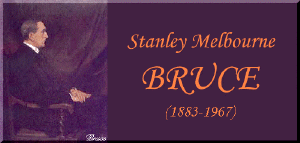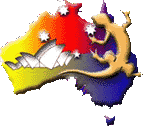|
     |
In 1929 the Maritime Industries Bill caused the defeat of Bruce's government. Bruce became the only prime minister ever to lose his own seat in an election. He regained it in 1931 but left Parliament for the post of High Commissioner in London, held from 1933-1946. "I was bulldozed into politics," Bruce declared. Described by Manning Clark as "naturally aloof,"with an Oxford accent and the best of English fashion (he always wore spats), Bruce formed a Coalition with Earle Page and together they governed Australia for six and a half years. Born in Melbourne on April 15, 1883, Bruce came from a privileged family and was wealthy all his life. He studied at Cambridge University, was appointed chairman of the family company and in 1907 was called to the Bar. He married Ethel Dunlop in 1913. At the beginning of the Great War he became an officer, was wounded at Gallipoli and then served at Suvla Bay where he earned the Military Cross. He was persuaded to run for federal Parliament in 1918. In 1921, whilst in England, he was asked to represent Australia at the League of Nations in Geneva. After the December 1922 election the Country Party under Earle Page forced the resignation of Hughes, and Bruce was appointed as his successor. The Coalition between Bruce's National Party and the Country party enjoyed prosperous economic times. They pursued a policy of development by protecting industry and awarding export bounties to farmers; increasing British migration and investment; establishing the Loans Council to control state borrowings; and keeping a tight rein on union activities. Compulsory voting was introduced in 1924 and the country responded by giving the Coalition a healthy majority in the 1925 and 1928 elections. In 1926 the Balfour Declaration recognised the equality and independence of the self-governing dominions. The Governor-General became the representative only of the Crown, not of the British Government. That same year, the Council for Scientific and Industrial Research (later C.S.I.R.O.) was established. Bruce allocated funds to hasten the development of Canberra as the National Capital, and in May 1927 the provisional Parliament House opened; the House would remain provisional for 61 years. Bruce entertained the Duke and Duchess of York at the opening. As Canberra had been declared 'dry', toasts to His Majesty were drunk with fruit cup. Bruce's downfall was the 1929 Maritime Industries Bill, aimed at handing over arbitration to the states except in the case of the maritime industries. This was unlikely to favour workers as most states had right-wing governments. Hughes put forward an amendment that toppled the government by one vote-another election had to be held. The Coalition lost the election and Bruce lost his seat. He regained his seat in 1931 but Lyons offered him the post of High Commissioner in London, a position he held until 1946. In 1947 he was made a viscount, Lord Bruce of Melbourne, but rarely sat in the House of Lords. He held the post of Chancellor of the Australian National University from 1951 but only attended ceremonial occasions. He lived in London until his death in 1967. Copyright unknown |
|
|
|
[ Virtual
Australia | The
World We Live In | The
Things We Do ]
Problems/Broken Links can be reported
to
All text and
graphics unless otherwise stated are ©1998-2000 Kim Holden, Virtual Australia.
|

![[Visit Oska]](../../images/oska003.gif)
